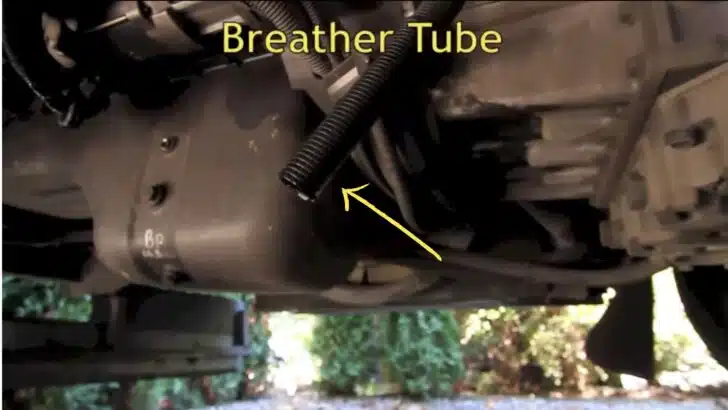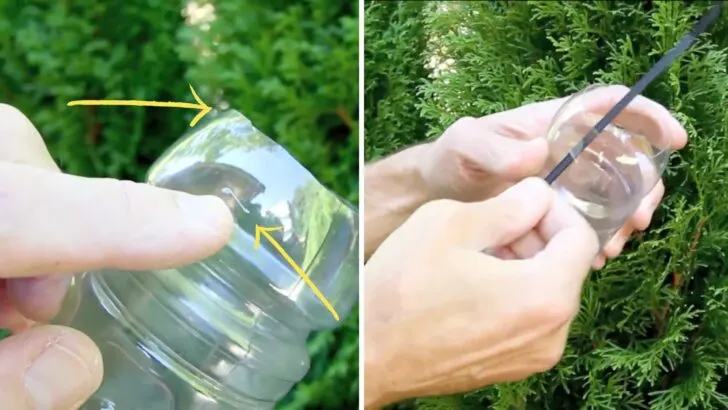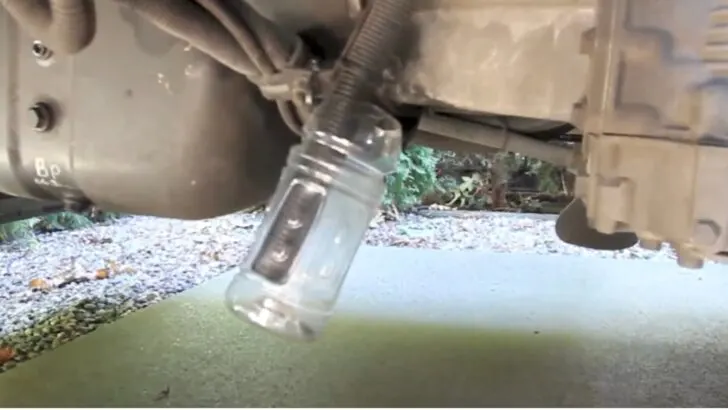If your RV is a diesel pusher and you sometimes find tiny specks of oil on the front of your towed car, you may be dealing with something called diesel engine blowby. In this post, we’ll share the likely source of this problem and how to stop engine blowby from getting on your toad with a simple trick that’s virtually FREE.
What Is Diesel Engine Blowby?
“Blowby” (sometimes written as “blow by” or “blow-by”) is the term used to describe the air-fuel mixture (the mix of fuel, engine oil, moisture, and combustion gases) that escapes from a diesel engine and gets blown out through the crankcase vent tube (also called the “breather tube” or “slobber tube”).
Most blowby occurs when exhaust gas gets past the piston rings and enters the crankcase (which can also happen with turbochargers). But any combustion gases or pressure that leak into the engine’s crankcase can produce blowby.
Manufacturers install the breather tube/slobber tube to redirect the oil down below the engine. That’s how this mess can end up splattered onto the front of your toad.
Do All Diesel Engines Have Blowby?
All diesel engines have some level of blowby, but an engine in good condition generally has only a minimal amount. However, even a little blowby can result in specs of oil accumulating on your towed car.
Even brand-new diesel engines may have some oil blow-by, as the seals in the engine components don’t seal 100%, even when they’re new. No matter how old your RV is, an engine that’s been overfilled with oil can be a big contributor to blowby.
What Is a Slobber Tube?
“Slobber tube” is a slang term that refers to the breather tube (or positive crankcase ventilation hose) that is usually visible beneath the engine. This hose or tube is part of the crankcase ventilation system. Its purpose is to allow excess combustion gasses to escape from the engine.

This is the breather tube (or “slobber tube”) under our 2005 Newmar Mountain Aire diesel pusher.
Is Blowby Normal?
Some blowby is to be expected, and this post addresses normal (minor) blowby that can occur with many diesel engines. In our case, we wanted to keep it from splattering small amounts of oil onto our RV’s towed car as we drove.
Excessive blowby, however, is an entirely different matter. We’ll talk more about this later in the post.
But, even a perfectly operating diesel engine can have some blow-by. In addition, if your oil is overfilled, some of it can get into the breather tube, causing it to spray out behind your RV (and onto your towed car) as you drive down the road.
We would sometimes see signs of it on the front of our towed car after longer drives, especially after having the RV’s engine oil changed. In our case, we think our engine’s dipstick may have been miscalibrated. When showing “FULL” it was actually slightly high.
So, the easiest solution is to avoid overfilling your crankcase. But unless you change your oil yourself, you might not always have total control over that. When having our oil changed at an RV shop, we generally asked that they set the level about halfway between the “full” and “add” lines on the dipstick (about 1/2 quart low), and that helped a lot.
Still, we would sometimes get small brown oily droplets along the front bumper, hood, and windshield of our CR-V… until we tried a simple trick we’re about to share with you now.
How to Keep Blowby Oil Off Your RV’s Towed Car
To stop blowby on a diesel engine and keep the oil off your RV’s towed car, you’ll need only about 15 minutes and the following items:
- A small, empty, rigid plastic bottle such as those from iced tea or vitamin water
- Any size standard zip-tie/cable tie (or, if you’re in Canada, a “Zap strap”)
- A utility knife, box cutter, or industrial razor blade
This tip is effective and requires only an empty (but rigid) plastic bottle and a standard zip tie. Make sure to use the heavy-duty plastic type from something like an iced tea as opposed to one of those flimsy, super thin water bottles. You’ll also need a box cutter or some type of razor knife to cut the top cleanly off the bottle.
Here are the simple steps to stop blow-by from blowing oil onto your toad, even if your engine’s crankcase is overfilled.
Cut the Top Off the Bottle
Using your razor knife or similar sharp blade, cleanly cut off the top of the bottle. You want to open it up wide enough for the breather tube to fit into the opening, plus some extra space around the tube. You’ll get the idea from the photos below.
Cut a Slit Into the Bottle and Insert the Zip Tie
Again using your razor knife, make a small horizontal slit near the top of the bottle (about an inch down is fine) as shown in the photo below. Then slide your zip tie about halfway into the slit, as shown on the right-hand side of the photo.

After cutting off the top of your rigid plastic bottle, you’ll make a small slit about an inch from the top (left) into which you’ll then slide your standard zip-tie (right).
Now your blowby spatter solution is ready to install.
Install the Blowby Bottle Solution
Slide the bottle up over the end of the breather tube and zip-tie it loosely to an existing clamp or fitting. Then clip the end off the zip tie and your solution is installed, ready to catch any blow-by before it splatters onto your car.

Slip the bottle over the breather tube/hose and then zip-tie it to an existing clamp or fitting, and your blowby spatter solution is in place. This is the view under the engine of our 2005 motorhome. You can see the oil pan just to the left and behind the slobber tube bottle.
A bonus is the ability to see how much oil is blowing out of your breather tube by looking at the bottle from time to time. It should be easily visible from the side by looking under the rear of the motorhome. If you’re seeing a lot of oil building up in the bottle, try keeping your oil level a little bit lower.
If you’re concerned about the bottle being damaged as you drive, we can tell you that we had our bottle in place for more years than we can count (we owned our Mountain Aire for over 18 years) without any problem.
We checked it regularly, and other than getting dirty, the integrity of the bottle remained intact over time. We replaced it a few times over the years simply because it had gotten so oily and dirty. If you were to have an issue with your bottle being damaged, it’s good to know that all you’d need is another zip tie and an empty rigid plastic bottle to replace it.
An alternative to using a bottle as a slobber tube cover/catch basin is to install a commercial blowby oil catch can tank like this one along the line that runs from the PCV valve to the intake or intake manifold:
- [ Capture Oil & Keep Engine Clean ]-- The oil catch tank will catch the oil and moisture from PCV/CCV air, prevent carbon and sludge build-up in the...
- [ Good Sealing to Prevent Leakage ]-- Fully Tig Welded and comes with O-ring gasket in fittings to prevent oil leakage, works great as a sealed catch...
Be sure to look for a high-quality catch can kit that uses a baffle or filter. Lower quality kits may have catch cans with no filtration, and those will do little to prevent oil blow-by. The unit we linked to above is a universal product. You can also provide your vehicle’s year, make, model, and engine trim at your local auto parts store to get a kit designed specifically for your setup.
How Do I Know If My Diesel Engine Has Excessive Blowby?
Again, some small amount of oil blowby is normal. Excessive blow by can be a sign of more serious issues with your engine. For example, if your engine’s piston rings aren’t properly sealed or don’t have a good fit, they’re less likely to be able to contain the pressure produced from the combustion, so they may leak.
Also, as the engine’s pistons move up and down in the cylinders, the rings and cylinder walls can wear to the point where they no longer maintain the proper seal. As components wear over time, the problem can increase, causing more blow-by.
Excess oil on your toad can be a sign of something far more severe than oil that’s been overfilled. In our 18+ years in our Newmar, we required engine repairs twice. The first symptom in both cases was excess oil on our toad. It was not coming from our breather tube, which would have caught it in the bottle. Had we not taken that oil seriously and acted promptly, we would have had far more serious engine problems.
Some symptoms of bigger problems to watch out for include:
- Loud noise coming from the engine, with or without a cloud of exhaust
- White smoke coming from the oil-fill tube or valve cover
- Increased oil and/or fuel consumption
- Misfiring or rough idling
- Soot and/or black smoke from carbon buildup
More than one of these symptoms together could indicate a more serious problem. But each one on its own can indicate other issues as well. For example, you could have an engine that consumes a lot of motor oil, burned inside the combustion chamber, but has minor/acceptable blowby.
If you suspect excessive blowby, you could install a bottle as suggested above and monitor the buildup in it by keeping a close eye on the bottle, especially after long drives.
We hope this trick helps you keep your tow car cleaner, like it did for us. For a step-by-step visual guide to our solution, check out our video:
For more ideas and tips, see our posts on 10 RV tips and tricks and 35 genius car hacks.
Free RVing Tips, Tricks, Reviews & Giveaways
As 20-year full-timers, we share everything we’ve learned about RVing over the years. Join our online community to receive a wealth of great RVing knowledge delivered daily to your inbox.
Whether you’re a new RVer or a seasoned full-timer, you’ll love the wide range of RVing topics we cover. Don’t miss a single article or any of our famous Giveaways. Subscribe to our newsletter today!



James
Monday 8th of February 2016
Great Idea,,,one question: does the heat from pavement or engine cause damage to the bottle which would require the bottle to be replace?
TheRVgeeks
Monday 8th of February 2016
We've had the same bottle on there for a couple of years, and other than being seriously dirty, it's like new! So we're gonna say no to that one. ?
elizabeth
Thursday 5th of March 2015
Clever! Thank you.